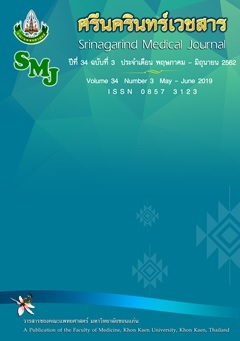Dietary Calcium Intake of University Students with Self-reported Lactose Intolerance
Keywords:
milk consumption, dietary calcium intake, self-reported lactose intoleranceAbstract
การบริโภคอาหารที่มีแคลเซียมในนักศึกษามหาวิทยาลัยที่มีภาวะไม่ทนต่อน้ำตาลแล็กโทสจากการประเมินตนเอง
สุจิตรา สมุหเสนีโต
สำนักวิชาแพทยศาสตร์ มหาวิทยาลัยวลัยลักษณ์ อ.เมือง จ. นครศรีธรรมราช
หลักการและวัตถุประสงค์: คนที่มีภาวะไม่ทนต่อน้ำตาลแล็กโทสหลีกเลี่ยงการดื่มนมอาจทำให้ได้รับแคลเซียมไม่เพียงพอ เสี่ยงต่อการเป็นโรคกระดูกพรุนในอนาคต การศึกษานี้มีวัตถุประสงค์เพื่อสำรวจปริมาณแคลเซียมที่ได้รับจากอาหารในนักศึกษาที่มีภาวะไม่ทนต่อน้ำตาลแล็กโทสจากการประเมินตนเอง
วีธีการศึกษา: การศึกษาวิเคราะห์แบบตัดขวาง ประชากรศึกษาคือนักศึกษา มหาวิทยาลัยวลัยลักษณ์ กลุ่มตัวอย่างได้จากการสุ่มแบบง่าย 383 ราย เก็บข้อมูลโดยใช้แบบสอบถามสัมภาษณ์โดยตรงเรื่องอาการทางระบบทางเดินอาหารหลังจากดื่มนม พฤติกรรมการดื่มนม ปริมาณแคลเซียมที่ได้รับ
ผลการศึกษา: นักศึกษาเป็นเพศหญิงร้อยละ 66.84 อายุเฉลี่ย 19.76 ± 1.32 ปี ร้อยละ 38.12 มีภาวะไม่ทนต่อน้ำตาลแล็กโทสจากการประเมินตนเอง อาการส่วนใหญ่คือปวดท้อง ร้อยละ 65.07 ปริมาณแคลเซียมที่ได้รับต่อวันไม่มีความแตกต่างกันในนักศึกษาที่มีภาวะไม่ทนต่อน้ำตาลแล็กโทสกับนักศึกษาปกติ ร้อยละ 81 ได้รับแคลเซียมน้อยกว่าครึ่งหนึ่งของปริมาณแคลเซียมที่ได้รับต่อวัน แหล่งของแคลเซียมจากอาหารมาจากผักใบเขียว ร้อยละ 53.53 รองลงมาคือนมและผลิตภัณฑ์จากนมคิดเป็นร้อยละ 42.30
สรุป: นักศึกษาที่มีภาวะไม่ทนต่อน้ำตาลแล็กโทสและนักศึกษาที่ไม่มีภาวะดังกล่าวได้รับแคลเซียมจากอาหารไม่เพียงพอ ควรส่งเสริมการบริโภคอาหารที่มีแคลเซียมสูงให้มากขึ้น
Background and Objective: People who have lactose intolerance tend to avoid milk consumption. This leads to inadequate calcium intake and development of osteoporosis. The present study examined dietary calcium intake of university students with self-reported lactose intolerance.
Methods: A cross-sectional analytical study was conducted in students of Walailak University. Three hundred and eighty-three samples were selected through simple random sampling method. Gastrointestinal symptoms, milk consumption behavior and dietary calcium intake were assessed using interviewer administered questionnaire.
Result: Most of the students were female (66.84%). The mean age was 19.76 ± 1.32 years and 38.12% had self-reported lactose intolerance. The most common symptom of lactose intolerance was abdominal pain (65.07%). There was no statistical significance between students with self-reported lactose intolerance and those without in daily calcium intake. Eighty-one percent had less dietary calcium intake than half of the recommended level. The major food sources of dietary calcium intake was leafy green vegetables (53.53%) followed by milk and milk product (42.30%).
Conclusion: Students with self-reported lactose intolerance and those without did not meet dietary recommended calcium intake level. Calcium-rich foods consumption should be promoted.
References
Bayless TM, Brown E, Paige DM. Lactase Non-persistence and Lactose Intolerance. Curr Gastroenterol Rep 2017; 19: 23.
Densupsoontorn N, Jirapinyo P, Thamonsiri N, Chantaratin S, Wongarn R. Lactose intolerance in Thai adults. J Med Assoc Thai 2004; 87: 1501-5.
Nicklas TA, Qu Haiyan Qu, Hughes SO, He M, Wagner SE, Foushee HR et al. Self-perceived lactose intolerance results in lower intakes of calcium and dairy foods and is associated with hypertension and diabetes in adults. Am J Clin Nutr 2011; 94: 191-8.
Keith JN, Nicholls J, Reed A, Kafer K, Miller GD. The prevalence of self-reported lactose intolerance and the consumption of dairy food among African American adults are less than expected. J Nat Med Assoc 2011; 103: 36-45.
Zheng X, Chu H, Cong Y, Deng Y, Long Y, Zhu Y, et al. Self-reported lactose intolerance in clinic patients with functional gastrointestinal symptoms: prevalence, risk factors, and impact on food choices. Neurogastroenterol Motil 2015; 27: 1138-46.
Di Stefano M, Veneto G, Malservisi S, Cecchetti L, Minguzzi L, Strocchi A, et al. Lactose malabsorption and intolerance and peak bone mass. Gastroenterology 2002; 122: 1793-9.
Matlik L, Savaiano D, McCabe G, VanLoan M, Blue CL, Boushey CJ. Perceived milk intolerance is related to bone mineral content in 10- to 13-year-old female adolescents. Pediatrics 2007; 120: e669-e77.
วิชัย เอกพลากร, วราภรณ์ เสถียรนพเก้า, บรรณาธิการ. รายงานการสำรวจการบริโภคอาหารของประชาชนไทย การสำรวจสุขภาพประชาชนไทยโดยการตรวจร่างกาย ครั้งที่ 4 พ.ศ.2551-2552. นนทบุรี: สำนักงานสำรวจสุขภาพประชาชนไทย สถาบันวิจัยระบบสาธารณสุข; 2554.
จุฬาลักษณ์ โกมลตรี. การคำนวณขนาดตัวอย่าง. วารสารสุขภาพจิต แห่งประเทศไทย 2555; 20: 192-8.
Judprasong K, Puwastien P, Nitithamyong A, Sridonpai P, Somjai A. Thai Food Composition Database [Internet]. 2016, [cited March 27, 2016]. Available from: http://www.inmu.mahidol.ac.th/thaifcd
Thong-Ngam D, Prempracha J, Suwangool P. Lactose intolerance is associated with changing of intestinal villi in Thai people. Thai J Gastroenterol 2004; 5: 14-8.
Jellema P, Schellevis FG, van der Windt DA, Kneepkens CM, van der Horst HE. Lactose malabsorption and intolerance: a systematic review on the diagnostic value of gastrointestinal symptoms and self-reported milk intolerance. QJM 2010; 103: 555-72.
Nutrition Division, Dietary Referrence Intake for Thais 2003. 4th ed. Bangkok: Ministry of Public Health; 2003.
Sornsuvit C, Saowapichart P, Meechai S, Longlaloeng A. Dietary calcium intake assessment by short food frequency questionnaire in Thais adults living in Chiang Mai, Thailand. J Pharm Nutr Sci 2011; 1: 166-70.
Pongchaiyakul C, Charoenkiatkul S, Kosulwat V, Rojroongwasinkul N, Rajatanavin R. Dietary calcium intake among rural Thais in Northeastern Thailand. J Med Assoc Thai 2008; 91: 153-8.
Pongchaiyakul C, Kosulwat V, Charoenkiatkul S, Chailurkit LO, Rojroongwasinkul N, Rajatanavin R. The association of dietary calcium, bone mineral density and biochemical bone turnover markers in rural Thai women. J Med Assoc Thai 2008; 91: 295-302.
Joo N-S, Dawson-Hughes B, Kim Y-S, Oh K, Yeum K-J. Impact of calcium and vitamin D insufficiences on serum parathyroid hormone and bone mineral density. J Bone Min Res 2013; 28: 764-70.
แนวทางเวชปฏิบัติสำหรับโรคกระดูกพรุน พ.ศ. 2553. กรุงเทพ: มูลนิธิโรคกระดูกพรุนแห่งประเทศไทย
การศึกษาชีวประสิทธิผลของแคลเซี่ยมในอาหารไทยบางชนิดจากองค์ประกอบทางเคมีของอาหาร [อินเตอร์เน็ต]. [เข้าถึงเมื่อ 25 มิถุนายน 2561] เข้าถึงได้จาก: http://www.inmu.mahidol.ac.th/th/research/
completed-research/group-I/research-project/index.php?id=22


